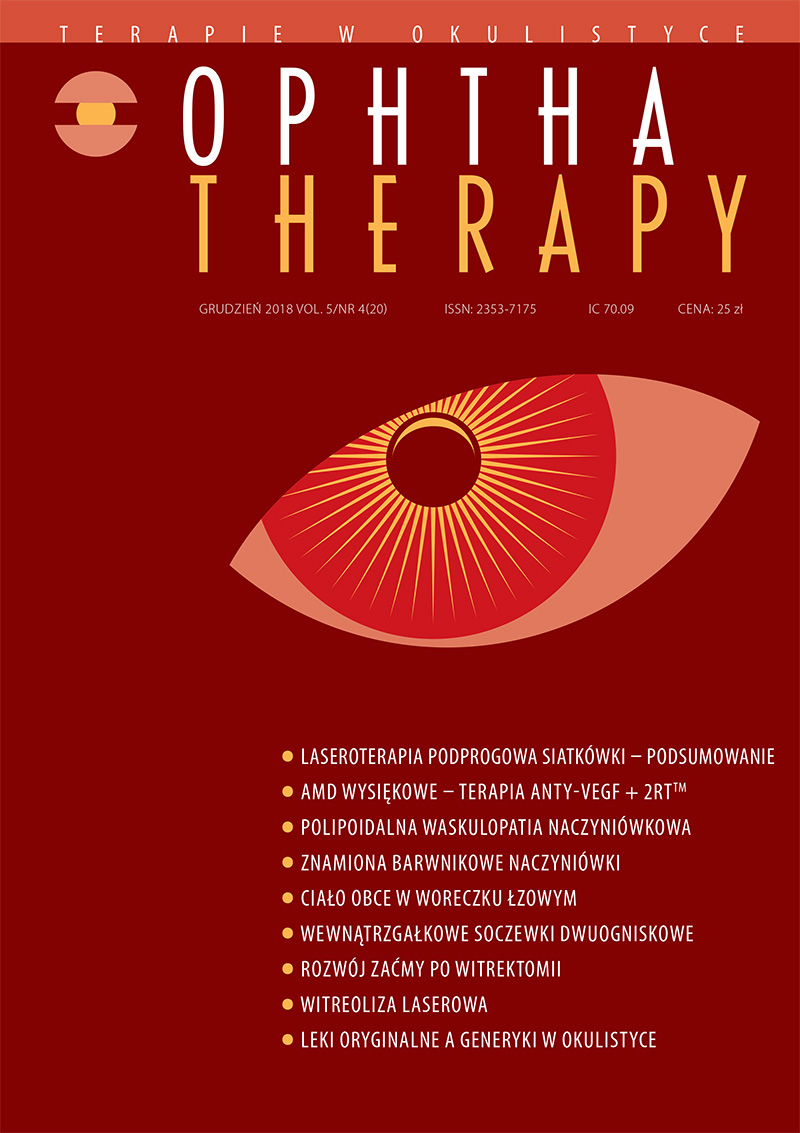Branded and generic drugs in ophthalmic therapy
Main Article Content
Abstract
Brand-name and generic drugs are commonly used in ophthalmologic practice. They need to meet specific requirements to ensure good therapeutic quality and not cause undesirable effects. Ophthalmology drugs are topical drugs and, therefore, do not lend themselves to certain pharmacokinetic studies and their absorption is affected by many factors. The doctor has to consider a number of aspects before prescribing a particular drug.
Downloads
Article Details

This work is licensed under a Creative Commons Attribution-NonCommercial-NoDerivatives 4.0 International License.
Copyright: © Medical Education sp. z o.o. License allowing third parties to copy and redistribute the material in any medium or format and to remix, transform, and build upon the material, provided the original work is properly cited and states its license.
Address reprint requests to: Medical Education, Marcin Kuźma (marcin.kuzma@mededu.pl)
References
2. Surowiec P, Hałaburda K. Leki generyczne – czym są, jakie niosą korzyści i czy są tak samo skuteczne jak leki referencyjne. Prawofarmaceutyczne.info 22.01.2018 r.
3. Harris A. Leki generyczne w okulistyce. WMW Górnicki, Wrocław 2013: 1, 2, 42, 62.
4. Simoenes S. Developing competitive and sustainable Polish generic medicines market. Research Centre for Pharmaceutical Care and Pharmaco-Economics, Katholike Universiteit Leuven 2009; 50: 440.
5. Chlebda-Sieragowska E. Zalety stosowania leków generycznych. W: Prost M. Kliniczna farmakologia okulistyczna. Wyd. 2. Edra, Wrocław 2016; I.10c: 143-9.
6. Gallelli L, Palleria C, De Vuono A et al. Safety and efficacy of generic drugs with respect to brand formulation. J Pharmacol Pharmacother. 2013; 4(suppl 1): 110-4.
7. Huml RA, Rich C, Chance K. Key challenges to US topical drug development. Regulatory Focus. 2009; 14: 47-52.
8. Davis JL, Gliger BC, Robinson MR. Novel approaches to ocular drug delivery. Curr Opin Mol Ther. 2004; 6: 195-205.
9. Brechue WF, Maren TH. pH and drug ionization affects ocular pressure lowering of topical carbonic anhydrase inhibitors investigative. Ophthalmol Vis Sci. 1993; 34: 2581-7.
10. Koevary SB. Pharmacokinetics of topical ocular drug delivery. Curr Drug Metab. 2003; 4: 213-22.
11. Terry JE, Hill RM. Human tear osmotic pressure: diurnal variations and the closed eye. Arch Ophthalmol. 1978; 96: 120-2.
12. Kocić I. Leki generyczne – czy są naprawdę takie same jak leki oryginalne? W: Prost M. Farmakologia okulistyczna. Wyd. 2. Edra, Wrocław 2016; I.10B: 139-42.
13. Vansant Vliet L, Ludwig A. Determinants of eye drop size. Surv Ophthalmol. 2004; 49(2): 197-213.
14. German E, Hurst M, Wood D. Reliability of drop size from multi-dose eye drop bottles: is it cause for concern? Eye (Lond). 1999; 13(1): 93-100.
15. Bauduin C, Labbe A, Liang H. Preservatives in eyedrops: The good, the bad, the ugly. Prog Retin Eye Res. 2010; 29(4): 312-34.
16. Czech A, Jachowicz R. Postać leku: optymalizacja leków doustnych i do oczu w nowoczesnej technologii farmaceutycznej. Wydawnictwo Lekarskie PZWL, Warszawa 2014.
17. Gabison EE, Chastang P, Menashi S et al. Late corneal perforation after photorefractive keratectomy associated with topical diclofenac: involvement of matrix metalloproteinases. Ophthalmology. 2003; 110(8): 1626-31.
18. O’Brien T, Li Q, Sauerburger F et al. The role of matrix metalloproteinases in ulcerative keratolysis associated with perioperative diclofenac use. Ophthalmology. 2001; 108(4): 656-9.
19. Tatsuhiko A, Nakagami T, Mochizuk M et al. Three cases of corneal melting after installation of a new nonsteroidal anti-inflammatory drug. Cornea. 2006; 25(2): 224-7.
20. Lin J, Rapuano C, Laibson P et al. Corneal melting associated with use of topical nonsteroidal antiinflammatory drugs after ocular surgery. Arch Ophthalmol. 2000; 118(8): 1129-32.
21. Roberts CW, Nelson PL. Comparative analysis of prednisolone acetate suspensions. J Ocul Pharmacol Ther. 2007; 23(2): 182-7.
22. Roberts CW. A comparison of branded to generic prednisolone acetate for control of postoperative inflammation. IOVS. 2000; 41. 2000; 4: 15015.
23. Brian S, Jayat C, Desmis A et al. Pharmaceutical evaluation of the quality and delivered dose of US latanoprost generics. In: Abstracts presented at ARVO annual meeting; 2012.
24. Weir RF, Zaidi FH, Charteris DG et al. Variability in content of Indian generic ciprofloxacin eye drops. Br J Ophthalmol. 2005; 89(9): 1094-6.
25. Genzzani A, Pattarino F. Difficulties in the production of identical drug products from a pharmaceutical technology viewpoint. Drugs R D. 2008; 9(2): 65-72.

